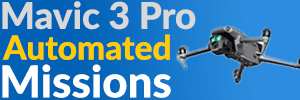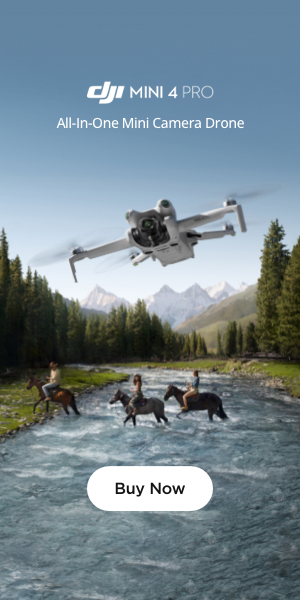I have been using DJI drones since 2016. In my opinion, the Phantom 4 Pro is the best model that DJI has made. A while back, I got a Mavic 3 Classic just to see what it could do. I flew it several times but didn't like it. For one thing, what were they thinking when they removed the handles that make it so easy to catch a Phantom when landing under difficult conditions? We are living in a real world, and we often want to get photos and images from above under conditions that are not ideal. I have launched and recovered the Phantom many times under difficult conditions, such as from a ship in the Arctic in a fairly strong wind. It would be impossible (for me, at least) to fly the Mavic under such conditions.
I am currently traveling in Argentina and Chile. The main purpose of the trip required me to bring numerous cameras, lenses, and other sensitive electronics. With all of that stuff, there was no way to fit the Phantom in my carry-on bags. One of the advantages of the Mavic is that it's small. I was able to squeeze it into my carry-on bags along with the other photography equipment.
For several years, I had wanted to try using a drone from a ship to obtain videos and images of seabirds while hovering above with the camera aimed straight down There is a potential with this approach to get much better results than you can get from the deck of a ship that is rolling with the waves. During this trip, I had a golden opportunity -- a boat ride off the coast of Chile to the ultra-rich Humboldt Current. During such trips to observe seabirds, they throw out chunks of fish to attract the birds. We had five species of albatross along with various petrels, shearwaters, terns, etc. circling the boat.
I launched the drone, and it immediately started acting funny. I couldn't control it as usual -- not a good thing when you have a drone up over the water. However, I managed to get it into place and obtained some nice footage. With more than 30 minutes of battery left, I was hoping to get a lot more footage and experiment around with the angle of the camera and altitude, but suddenly it said that the storage had all been used. How could that be?? There is plenty of room on the data card for the longest possible Mavic flight.
After getting back from the sea trip, I realized that it had somehow decided to write to the internal memory. This is a really bad idea. Data cards offer plenty of memory, and they are inexpensive. Why add this option, which is a set-up for the kind of unfortunate failure and lost opportunity that I experienced (after traveling thousands of miles and paying a huge price for the boat trip)? I'm assuming that what happened is the data card wasn't seated properly (something that has never happened to me during hundreds of Phantom flights).
I realized that the unusual behavior was apparently due to the fact that the switch on the controller had gotten moved from N to C. This is another bad design that is a set-up for failure. It is easy to accidentally move this button and not even realize it. On a side note, I have an audio recorder on which it is easy to accidentally flip one switch to add 20 dB of loss and another to switch to an external microphone (which means you record silence). Not a good idea to include switches that are easy to accidentally flip and that have major consequences.
All of the problems mentioned above are bad enough, but the fact that the Mavic can't do flights programmed with Litchi was a gigantic step backwards in capability. A real step forward would be a drone that has the advantages of the Mavic (longer flights and more compact and easier to carry) but retains the advantages of the Phantom -- a handle for grabbing it when landing under real world conditions and a lack of "features" that can cause problems at inopportune times.
I am currently traveling in Argentina and Chile. The main purpose of the trip required me to bring numerous cameras, lenses, and other sensitive electronics. With all of that stuff, there was no way to fit the Phantom in my carry-on bags. One of the advantages of the Mavic is that it's small. I was able to squeeze it into my carry-on bags along with the other photography equipment.
For several years, I had wanted to try using a drone from a ship to obtain videos and images of seabirds while hovering above with the camera aimed straight down There is a potential with this approach to get much better results than you can get from the deck of a ship that is rolling with the waves. During this trip, I had a golden opportunity -- a boat ride off the coast of Chile to the ultra-rich Humboldt Current. During such trips to observe seabirds, they throw out chunks of fish to attract the birds. We had five species of albatross along with various petrels, shearwaters, terns, etc. circling the boat.
I launched the drone, and it immediately started acting funny. I couldn't control it as usual -- not a good thing when you have a drone up over the water. However, I managed to get it into place and obtained some nice footage. With more than 30 minutes of battery left, I was hoping to get a lot more footage and experiment around with the angle of the camera and altitude, but suddenly it said that the storage had all been used. How could that be?? There is plenty of room on the data card for the longest possible Mavic flight.
After getting back from the sea trip, I realized that it had somehow decided to write to the internal memory. This is a really bad idea. Data cards offer plenty of memory, and they are inexpensive. Why add this option, which is a set-up for the kind of unfortunate failure and lost opportunity that I experienced (after traveling thousands of miles and paying a huge price for the boat trip)? I'm assuming that what happened is the data card wasn't seated properly (something that has never happened to me during hundreds of Phantom flights).
I realized that the unusual behavior was apparently due to the fact that the switch on the controller had gotten moved from N to C. This is another bad design that is a set-up for failure. It is easy to accidentally move this button and not even realize it. On a side note, I have an audio recorder on which it is easy to accidentally flip one switch to add 20 dB of loss and another to switch to an external microphone (which means you record silence). Not a good idea to include switches that are easy to accidentally flip and that have major consequences.
All of the problems mentioned above are bad enough, but the fact that the Mavic can't do flights programmed with Litchi was a gigantic step backwards in capability. A real step forward would be a drone that has the advantages of the Mavic (longer flights and more compact and easier to carry) but retains the advantages of the Phantom -- a handle for grabbing it when landing under real world conditions and a lack of "features" that can cause problems at inopportune times.












